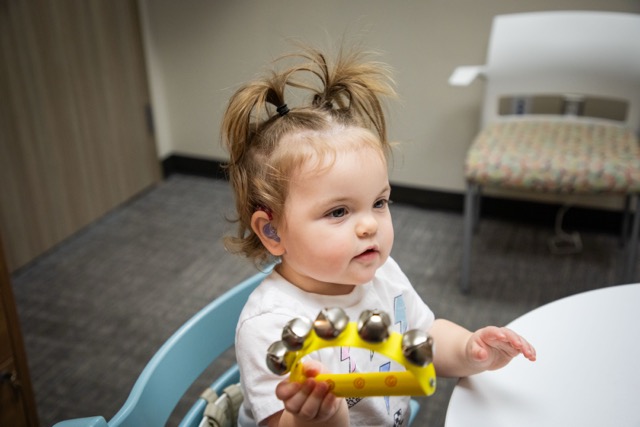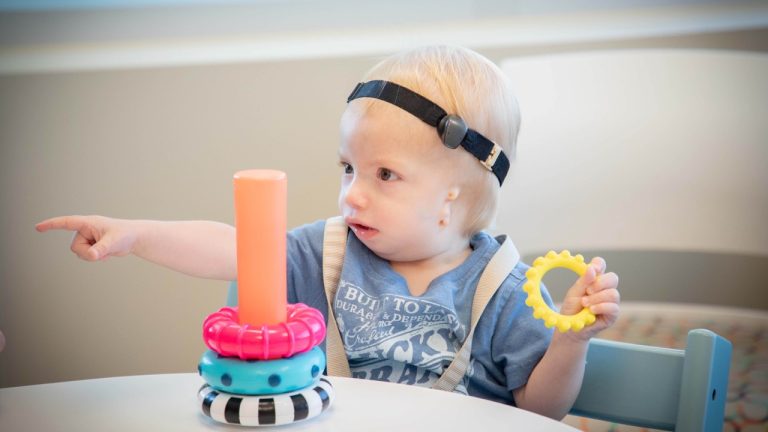
Hear Their Stories: Isla’s Hearing Loss Journey
19-month-old Isla is bubbly little girl who loves exploring, playing, reading, and dancing along to Elmo. Hear her story and hearing loss journey.
Home / Children / Eyes Open, Ears On / Hearing Technology
If your child has an accurate diagnosis of hearing loss, it is likely that your audiologist will recommend hearing technology. Hearing technology comes in a variety of forms and is recommended by considering the type of hearing loss, the amount of hearing loss, and the age of your child. It is important to fit technology as early as possible for the best listening and spoken language outcomes.
A behind-the-ear (BTE) hearing aid is the most common type of hearing technology for children with hearing loss. BTE hearing aids are made up of three parts: 1) the body of the hearing aid, 2) a thin tube or wire that is connected to the hearing aid, and 3) an earmold. The body of the hearing aid is a small electronic device that sits behind your child’s ear. The hearing aid contains a microphone that detects sounds and delivers them to a computer processor within the hearing aid. The processed sound is then amplified and delivered to the thin tube or wire where it is then sent to the earmold. The earmold is a soft earpiece that is customized to fit your child’s ear and deliver the sound toward your child’s ear drum. Hearing aids are programed using computers with special software that allows the audiologist to set the volume level (i.e., decibels) of the hearing aids so that allows your child to hear sounds at an audible and comfortable level. The style of the device may change slightly as your child gets older, but our pediatric audiologists will help your family decide on the option that best meets the needs of your child and will help with any questions or concerns you might have.
A bone conduction hearing device (which is also sometimes known as a bone anchored hearing aid [BAHA] or an osseointegrated hearing device) is designed for children who have conductive (external or middle ear dysfunction) hearing loss or who are deaf in only one ear (i.e., single-sided deafness). A bone conduction hearing device is made up of a small device that contains microphones that detect sound and delivers it to a computer processor. Once the sound is processed by the computer, it is converted to vibrations that are directed to the skull and to the inner ear. For children under 5 years old, the bone conduction hearing device is attached to a headband that positions the processor on the head. For children who are 5 years old and up, an ear surgeon can place an implantable titanium implant in the skull so that the processor may be connected to the implant to deliver vibrations directly to the skull. For children who have conductive hearing loss (i.e., persistent external or middle ear dysfunction), the bone conduction hearing device bypasses the non-working part of the ear and delivers the sound to the functioning inner ear. For children who are deaf in one ear, the bone conduction processor is worn next to the poorer hearing ear so that it can detect sound and transmit the sound vibrations across the skull to the better ear. Your child’s audiologist will determine whether this this device is the best option to meet for your child’s needs.
A cochlear implant system contains two components, 1) an external sound processor, and 2) a cochlear implant. The external sound processor is typically worn on the ear or head. It contains microphones that detect sound and deliver it to a computer processor. The processed sound is then delivered to an antenna that transmits the processed signal to the cochlear implant. The cochlear implant contains an antenna that captures the transmitted signal and delivers it to another computer processor that converts the signal to electrical pulses. The electrical pulses are delivered to a small wire that is implanted in the cochlea (i.e., the inner ear) to stimulate the hearing nerve.
Cochlear implants are often recommended for children who have severe to profound hearing loss (and also for some children with auditory neuropathy spectrum disorder) and who do not hear well enough with hearing aids to make age-appropriate progress in their listening and spoken language skills. For most children with severe to profound hearing loss, the hearing nerve functions well, but the inner ear does not. The cochlear implant bypasses the dysfunctional inner ear and sends the auditory signal directly to the hearing nerve and then onto the brain.
There are several factors that go into how well a child will hear with a cochlear implant, including but not limited to:
Cochlear implants may be recommended for one or both ears, depending on the type and level of hearing loss. A team of persons including the child’s family, audiologist, Listening and Spoken Language Specialist, ear surgeon, etc. will determine whether a cochlear implant is the best option to support a child’s well-being and development.
Remote microphone systems contain two components, 1) a microphone/transmitter, and 2) a receiver. The microphone is worn near the mouth of the talker (e.g., parent, teacher, etc.) to detect speech. The speech signal is delivered to a computer processor which delivers the signal to a radio transmitter. The transmitter then delivers the radio signal to a small antenna in the receiver which is connected to the listener’s hearing aid or cochlear implant sound processor. Remote microphone systems are the most effective technology for improving a child’s ability to understand speech in noisy environments and when the talker is more than a few feet away from the child. An audiologist can help you select a remote microphone system that best meets the needs of your child.
At Hearts for Hearing, we have seen many children thrive with hearing technology. These devices allow our patients to communicate, learn, and engage with their family and friends. If you have questions about hearing technology and are interested in learning more about hearing aids for your child, we encourage you to schedule an appointment with our team. We are committed to supporting your child’s hearing health journey and look forward to partnering with you to achieve your child’s optimal hearing health so they can listen for a lifetime.

19-month-old Isla is bubbly little girl who loves exploring, playing, reading, and dancing along to Elmo. Hear her story and hearing loss journey.

Mom describes the pregnancy and delivery as nothing out of the ordinary. Looking back, she remembers being comforted by the fact that a nurse mentioned how well Zoe slept that first night – even though other babies were crying all around her.

When Carter was born in early summer 2022, Mom and Dad say they were “blind-sided” when he was born with bilateral microtia. This is a condition defined as underdevelopment of the ear, which means the ear is either too small or not shaped as it should be, or both. Carter
We are closed for the holidays from 12/24 through 1/4. Email audassist@heartsforhearing.org for emergency support.